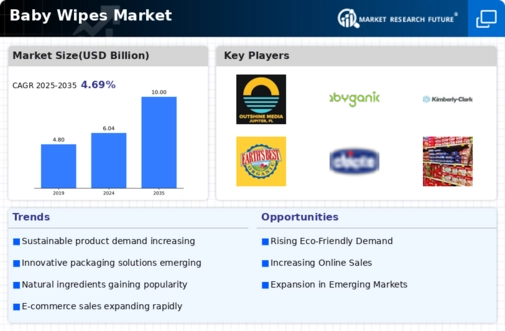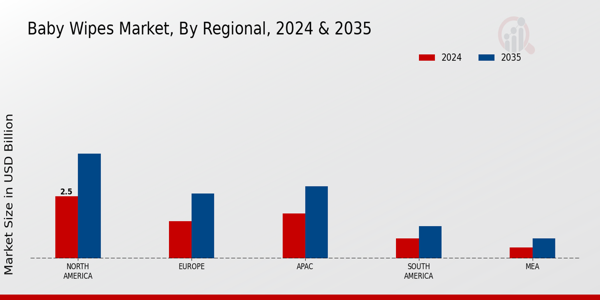Market Trends
Introduction
The Baby Wipes Market is experiencing a shift, driven by a combination of factors, including technological advancements, regulatory frameworks and changing consumer preferences. The market is characterized by a strong innovation drive, as well as by the emergence of a new generation of materials and production processes that improve the quality and sustainability of products. Moreover, stricter regulations regarding product safety and the environment are changing the formulations and packaging of products. Also, a growing consumer preference for hypoallergenic and eco-friendly products is influencing purchasing decisions, thus requiring brands to adapt their offerings accordingly. These trends are of strategic importance to the Baby Wipes Market, as they help companies to navigate the highly competitive landscape and to ensure that their products meet consumers’ expectations and comply with regulations.
Top Trends
-
Sustainability and Eco-Friendly Products
It is the result of a growing awareness of the environment among consumers. Companies such as Seventh Generation have led the way with their biodegradable materials, and government regulations are encouraging them to use less plastic. By 2023, sixty per cent of parents were preferring sustainable products, which represents a significant change. The trend is forcing manufacturers to look at new materials and new ways of packaging, with the potential to transform their supply chains. -
Natural and Organic Ingredients
The trend towards natural and organic baby wipes is a reflection of the general trend towards clean labelling. Brands like Babyganics are profiting from the trend, with 75% of consumers prepared to pay more for organic products. The trend is influencing the formulation of products and the marketing of brands as they strive to meet the consumers’ demands for transparency and safety. Perhaps in the future we will see a greater emphasis on the origin of ingredients. -
Increased Focus on Hypoallergenic Products
The number of consumers of hypoallergenic baby wipes is growing, as people are increasingly concerned about the sensitivity of their skin. Research shows that 40% of parents prefer hypoallergenic products for their children. Product lines are being reformulated to meet this demand, resulting in new marketing strategies. This trend is likely to lead to more rigorous testing and certification in the industry. -
Convenience and On-the-Go Packaging
There is a growing need for convenience, which is driving innovation in the packaging of products. The popularity of single-use and travel formats is on the rise. Brands are introducing resealable packs and smaller formats to meet the needs of busy parents. A majority of consumers (55%) prefer portable formats. This trend is having a significant impact on the distribution strategies of retailers, who are adapting to changing consumer habits. In future, the introduction of smart packaging solutions may enhance the consumer experience. -
Technological Advancements in Product Design
Advances in technology have made possible the development of improved products, such as wipes with soothing ingredients. And since about one-third of consumers are interested in such products, companies are investing in research and development to create wipes with more than one benefit. This trend is causing companies to differentiate their products in a crowded market, which may eventually lead to new product categories. And in the future, smart wipes may be able to monitor the health of consumers’ skin. -
Personalization and Customization
Personalization is a growing trend in the baby wipes market, with some brands offering personalization options based on skin type or fragrance preference. A recent survey showed that 45% of parents are interested in personalizing their children’s products. This trend is pushing companies to explore new direct-to-consumer business models and tailor-made marketing strategies. Subscription services for personalizing baby products could be a future trend. -
Expansion of E-commerce Channels
The expansion of e-commerce is changing the way baby wipes are marketed and sold, and the post-pandemic growth of e-sales is very considerable. In 2023, seven out of ten parents said they were buying baby products on the Internet. Brands are therefore increasing their digital presence. This trend is increasing competition between retailers and forcing them to adopt more aggressive digital marketing strategies. Future developments might include augmented reality tools that allow virtual product trials. -
Health and Safety Regulations
The stricter health and safety regulations have a bearing on the product formulations and the claims made for the baby-wipes market. Brands are now being subjected to closer scrutiny on the safety of their ingredients, and half of them have had to change their formulations to comply with new standards. This trend is driving innovation in safer alternatives and greater clarity in labelling. The future could see even more stringent controls and penalties for non-compliance. -
Diverse Product Offerings for Different Needs
The product range is diversified to meet the various needs of consumers, such as those with sensitive skin and those with a certain age. Brands have launched special lines, with 65% of parents seeking products adapted to their child’s needs. This trend is driving the industry to develop more specialised ranges and more targeted marketing. Product endorsements by dermatologists are one possible future development. -
Global Market Expansion
The global market for baby diapers is expanding and emerging countries are demanding quality products. The birth rate is rising and changing preferences are leading to strategic alliances and localized marketing. In 2023, forty per cent of brands were reported to be entering new markets. There may be a need to change the formulation of products to meet local preferences and regulations in the future.
Conclusion: Navigating the Baby Wipes Market Landscape
The market for baby wipes is characterised by a high degree of fragmentation. Both new and established players are competing for market share with new product developments and strategic positioning. The trend towards more sustainable and eco-friendly products is driving suppliers to enhance their capabilities in terms of automation and sustainable production. The established players are taking advantage of their market positions and integrating the latest technology such as artificial intelligence to optimize their supply chains and improve customer relationships. The new players are focusing on flexibility and niche marketing to capture market share from a specific customer segment. In the future, the ability to harness artificial intelligence, integrate automation and commit to sustainable production will determine market leadership. Suppliers will be forced to adapt to these new market conditions quickly to maintain their competitive edge.















Leave a Comment